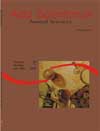<b>Royal jelly production by Italian and Africanized honeybees <em>Apis mellifera</em>, descendants of their crossing</b> - DOI: 10.4025/actascianimsci.v27i1.1254
Abstract
This work aimed at comparing royal jelly production among descendants of Italian queen sisters inseminated by Africanized drones (T1), Italian drones (T2) and Africanized queen sisters in natural mating (T3). The workers cross-bred (T1) accepted more transferred larvae (45.41%) but there was no significant difference. They deposited more (P < 0.05) royal jelly in each cup (243.5 mg) than Italians (T2 – 31.36% and 214.7 mg) and Africanized workers (T3 – 33.63% and 209.3 mg), respectively. The result showed a best production in each colony which suggests heterosis. These parameters showed positive relation with pollen and workers quantities and with environmental temperature. The best production occurred in February and March, period of absence of flower in orange and eucalyptus culture in this regionDownloads
Download data is not yet available.
Published
2008-03-20
How to Cite
Garcia, R. C., & Couto, R. H. N. (2008). <b>Royal jelly production by Italian and Africanized honeybees <em>Apis mellifera</em>, descendants of their crossing</b> - DOI: 10.4025/actascianimsci.v27i1.1254. Acta Scientiarum. Animal Sciences, 27(1), 17-22. https://doi.org/10.4025/actascianimsci.v27i1.1254
Issue
Section
Animal Breeding and Reproduction
DECLARATION OF ORIGINALITY AND COPYRIGHTS
- I Declare that current article is original and has not been submitted for publication, in part or in whole, to any other national or international journal.
The copyrights belong exclusively to the authors. Published content is licensed under Creative Commons Attribution 4.0 (CC BY 4.0) guidelines, which allows sharing (copy and distribution of the material in any medium or format) and adaptation (remix, transform, and build upon the material) for any purpose, even commercially, under the terms of attribution.
Read this link for further information on how to use CC BY 4.0 properly.
0.9
2019CiteScore
29th percentile
Powered by 








































